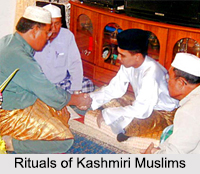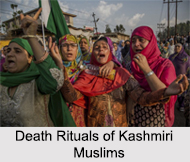 Rituals of Kashmiri Muslims mark all the important events of life, such as birth, marriage and death. They are carried out in accordance with the customs and traditions that have been long established by the Muslims residing in Kashmir. The Muslims of the Valley are very fond of celebrating their holy festivals with great enthusiasm. On the Id days they don their new clothes and attend mass prayers in the Idgahs of the towns and villages. Presents are exchanged between relatives and friends. Feasts are held and sumptuous dishes served.
Rituals of Kashmiri Muslims mark all the important events of life, such as birth, marriage and death. They are carried out in accordance with the customs and traditions that have been long established by the Muslims residing in Kashmir. The Muslims of the Valley are very fond of celebrating their holy festivals with great enthusiasm. On the Id days they don their new clothes and attend mass prayers in the Idgahs of the towns and villages. Presents are exchanged between relatives and friends. Feasts are held and sumptuous dishes served.
Some of the most important of these various rituals are discussed below:
Birth Rituals of Kashmiri Muslims
Many of the ceremonies connected with the birth of a Muslim child are similar to those among the Kashmiri Pundits. For instance, visiting shrines, calling the aid of saints and keeping religious fasts by childless parents in order that they might be blessed with children are common customs.
Among the Kashmiri Muslims, 1 or 2 months prior to the time for the confinement, the young wife generally goes to her parent"s house where she gives birth to the child. Immediately after the event, the Mullah comes in and taking the infant by the right ear, whispers the "Azan" welcoming the new arrival to this world of faith, and then he repeats in the left ear the "Takbir" and adds a warning that death is the end of all things. The young mother fasts for one or two days during which she takes only an infusion of certain herbs.
On the 7th day which is known as the "Sunder" day, the mother bathes and the child is given its name. The name is usually given according to the month in which the child is born. On the same day, a barber is called in and he shaves the child"s head. The neighbours and relatives are entertained in the feast. 2 or 3 months later the mother returns to her father-in-law"s house carrying with her presents, among which may be a calf or a pony or a mare.
 At the age of 4 or 5 years, the male child will be circumcised and this is an occasion of great rejoicings and festivities. The child"s feet are dyed with henna on the Manzirat night and the relatives and friends are invited to a good feast. For seven days before the ceremony, there is nothing but singing and feasting, and on the day of the circumcision the child is placed on a basket under which a cock is cooped, for the benefit of the barber who performs the circumcision. All friends and relatives kiss the child`s hand and give him money after which the guests go off to a shrine with the boy and return to the house for a feast.
At the age of 4 or 5 years, the male child will be circumcised and this is an occasion of great rejoicings and festivities. The child"s feet are dyed with henna on the Manzirat night and the relatives and friends are invited to a good feast. For seven days before the ceremony, there is nothing but singing and feasting, and on the day of the circumcision the child is placed on a basket under which a cock is cooped, for the benefit of the barber who performs the circumcision. All friends and relatives kiss the child`s hand and give him money after which the guests go off to a shrine with the boy and return to the house for a feast.
Marriage Rituals of Kashmiri Muslims
To the extent possible, the Muslims try to marry within their own tribe close to the family circle. The system of "Khana damad", where the bridegroom goes to live with the bride`s family, is quite prevalent. The custom of "Khanada Madi" is prevalent among cultivators and Hanjis. When a suitable match is found, a betrothal ceremony is held. A feast is held to celebrate the betrothal and the contract is sometimes committed in writing by a priest. There is a constant exchange of gifts between the families of the boy and the girl till the day of the final marriage. When the day for the final marriage is fixed, the boy`s father sends cash present as "lagan" to the girl`s father. On the wedding day, following the various customs and rituals, the boy and his party set off for the girl`s house, praying on the way from a neighbouring shrine and the graves of the bridegroom`s father or grandfather. As they approach the bride`s house, they are welcomed by the women of the bride`s party come out, singing the song of welcome and praising the bridegroom`s qualities. When the whole party is assembled, the groom sits on cushions and the feast commences winding up with tea. After the feast, the Qazi proceeds to the marriage of the bride and the groom. The bride then departs for to the groom"s house in a palanquin. The reception of the bride takes place amidst much gift-giving and fanfare.
Death Rituals of Kashmiri Muslims
The ceremonies connected with the death of a Musalman are quite simple. At the time of death, the "Kalma" and some verses from the Holy Quran are pronounced into the ear of the dying man. Those present around call on the name of God. The corpse is then bathed and wrapped in a shroud and carried to the graveyard in a wooden coffin (Tabut). The Tabut is covered with a black cloth from a shrine nearby. The burial is accompanied with recitations of the holy verses from the Quran and other sacred books. The mourners then pray for the peace of the soul of the departed and return to their homes. For some days till the next Friday, the chief mourner daily visits the grave with the Mullah and offers prayers. On the next Friday, all the friends and relatives of the departed gather at the grave and offer "Fatiha" or prayers. They then return to the house of the chief mourner and are served with light refreshments. For a year or two, the Mullah receives alms from the house of the departed on certain Muslim holy days. The graveyard is planted with irises, tulips, narcissi and some spring flowers.
Many rituals and ceremonies connected with birth, marriage and death, have, however, undergone reforms in consequence of modern socio-economic necessities.




















